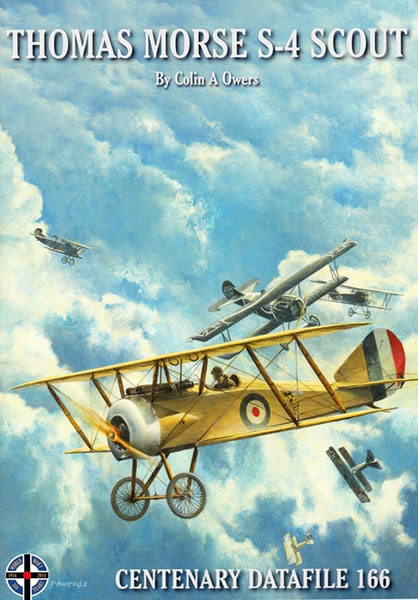|
Windsock Datafile 166
Thomas Morse S-4 Scout

Albatros Productions
S u m m a r y |
| Publisher and Title: |
Windsock Datafiles 166 - Thomas Morse S-4 Scout
Author: Colin A. Owers
Illustrators: Martin Digmayer & Ronny Bar
ISBN: 978-1-906798-38-3 |
| Media: |
Magazine binding, A4 portrait format, 32 pages, 70 B&W archive photos, 25 colour photos, 1/72 & 1/48 scale plans, and 6 colour profiles. |
| Price: |
Available online from Albatros Productions and Hannants for £11.90, and stockists worldwide. |
| Review Type: |
First Read |
| Advantages: |
Good images, excellent plans, informative. |
| Disadvantages: |
|
| Conclusion: |
This centenary datafile on the Thomas Morse S-4 is produced to a high standard. It includes some very interesting images, has excellent plans, is interesting to read, and provides a good insight into what was an important aircraft to the US Army, not to mention Hollywood’s movie industry.
I definitely recommend it, and look forward to more in the series. |
Reviewed by Mark Davies

HyperScale is proudly supported by Squadron.com
Windsock Datafiles have long been essential references for WW1 Aircraft modellers. They are published by Albatros Productions, whose managing director is Ray Rimmel; a name that should be familiar to many for his work as an author, editor, and modeller.
The Thomas-Morse S-4 Scout was an American biplane advanced trainer, operated by the United States Army and the United States Navy. Dubbed the "Tommy" by pilots who flew it, the aircraft became the favourite single-seat training airplane produced in the U.S. during World War I. It had a long and varied career beginning with the S-4B, which first appeared in the summer of 1917.
After World War I, many "Tommys" were sold as surplus to civilian flying schools, sportsman pilots, and ex-Army fliers. Many were still being used in the mid-1930s for World War I aviation movies, and several continue to exist in flying condition today.
Source: Wikipedia
This latest datafile does a good job of outlining S-4’s development and its service history is well covered, and its later civil use is also mentioned. It contains excellent images throughout, using a pleasing mix of period photos and modern colour shots.
The period photos are particularly interesting, and include post-war machines in various Hollywood movie colour schemes. The colour images are of a machine undergoing restoration, as well examples from flying collections; all of which serve as useful walk-around images. There are exquisitely drawn plans to 1/72 and 1/48 scales by Martin Digmayer, plus six attractive colour profiles by Ronny Bar on both sides of the rear cover.
Various appendices deal with specifications (including conflicting dimensional data), US Army contracts, S-4 disposition in 1919, US Navy serial numbers, and known airframes in 2104. There is also an extract from an original service manual providing rigging diagrams and instructions on “truing up” the airframe.
This centenary datafile on the Thomas Morse S-4 is produced to a high standard. It includes some very interesting images, has excellent plans, is interesting to read, and provides a good insight into what was an important aircraft to the US Army, not to mention Hollywood’s movie industry.
Windsock Datafiles have long been a staple reference for WW1 aircraft modellers and enthusiasts. This 166th edition in the series maintains the standard and reputation established over many years of publication. I definitely recommend it, and look forward to more in the series.

Review Copyright © 2015 by Mark Davies
This Page Created on 25 May, 2015
Last updated
25 May, 2015
Back to HyperScale Main Page
Back to Reviews Page
|
